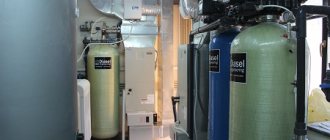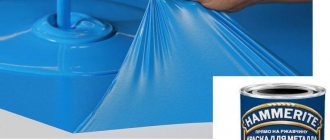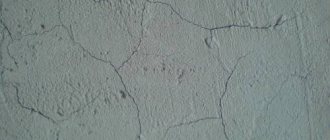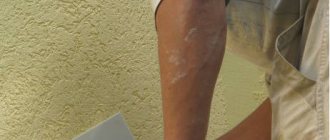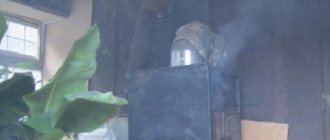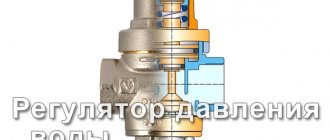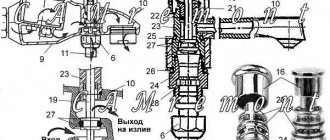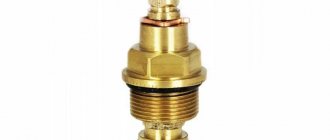Moisture accumulating on the surface of pipelines in bathrooms is a problem that many people are familiar with firsthand. This phenomenon is common, especially often observed in the summer, when the air warms up to high temperatures. It seems that nothing bad is happening, but the droplets can turn into streams, and such mini-rivers will become small puddles on the floor. What to do if condensation appears on cold water pipes? There are several reasons for the formation of moisture, which means that there are various effective solutions to this problem.
Why is it formed?
Condensation is expressed in the appearance of small drops of water or complete wetness of the surface of pipes with cold water.
There are only two main causes of condensation:
- an increase in air humidity caused by the appearance of a source of active evaporation of water;
- the appearance of colder surfaces, changing the temperature ratio and causing moisture to settle.
The conditions for the appearance of condensation are a combination of these factors, enhanced by a large difference in temperatures.
For example, if a constantly wet surface is heated, it will stop attracting water vapor.
Conversely, if it is cooled sharply, the appearance of condensation will become inevitable. This phenomenon in itself is not a sign of any dangerous or undesirable processes. Attention! Condensation is dangerous due to its consequences - moisture begins to be absorbed into the wall materials, dampness and mold appear, steel elements are destroyed (fasteners, plumbing parts, when penetrating deep into the concrete, the fittings begin to rust).
In the bathroom
The appearance of condensation in the bathroom can have various reasons:
- Immediately after taking water procedures (especially after a hot shower) is normal. If moisture covers all surfaces - tiles, mirrors and other cold surfaces, but quickly evaporates (in normal conditions this process takes only a few minutes), there is nothing to worry about. This indicates that the room has normal ventilation, which actively removes water vapor.
- Leaking hot water or hot water pipeline .
They are much more dangerous, as they pose a risk of flooding of the apartment, and not only your own. A particularly dangerous sign is a leak in a hot water pipe. This is evidenced by the constant appearance of steam in one area or another of the room. Hot water evaporates more actively and creates increased humidity in the air. Cold water pipes, on the contrary, attract condensation. If there is a leak (not necessarily in the pipeline itself, a possible cause could be a valve that is not closed tightly), the pipe is constantly wet.
In the toilet
In the toilet, condensation appears on the cold water pipes and on the flush tank (less often on the toilet itself).
The main reason is incorrectly configured tank mechanics , which creates a constant leak.
It is noticeable if you look closely at the upper area of the water outlet in the toilet bowl.
Reference! Most often, the problem can be resolved by adjusting the tank. As soon as the constant flow stops, moisture settling will noticeably decrease or stop altogether.
On the riser
Condensation on the riser indicates the appearance of a constant water leak either in your apartment or in the apartments of neighbors on the upper floors. The water does not stagnate and does not heat up, so the temperature of the riser is noticeably lower than that of surrounding objects.
If the water vapor content in the air is increased, the surface of the pipe will immediately become wet. If the reason lies in your apartment, eliminating it will not be much of a problem. It is worse if a constant leak occurs on the upper floors of neighbors, since it is sometimes extremely difficult to determine the source and somehow influence the residents.
If you liked the article, please share it
Previously on the topic:
Share
Does the material matter?
The material of the pipes has a significant influence on the occurrence of condensation.
The main indicator is thermal conductivity - the higher it is, the more moisture will settle on the surface.
pipes, both steel and brass, get wet the most
They quickly cool down when a cold stream passes and begin to attract water vapor from the air.
Plastic pipes are less susceptible to this phenomenon, since the thermal conductivity of polymers is much lower than that of metal.
On a note! The walls of plastic pipes have thermal insulation abilities that reduce the possibility of moisture settling. However, if the room is very hot and humid, the plastic surfaces will also become wet.
Steam traps
Since the problem of water condensation is widespread, there are devices that capture water vapor and remove the resulting liquid. In particular, condensate drains are installed at the outlet of water heaters. Depending on the heat exchange scheme, thermodynamic, thermostatic and mechanical devices are used.
The most popular are condensate traps that operate on the float principle. They separate accumulated water from steam and remove it from the system, using the difference in density between water and steam.
Float devices have the following advantages:
- exceptional reliability;
- high performance;
- optimal energy saving in the system.
In an apartment and in a private house - what is the difference?
Water supply systems for private and apartment buildings differ in size. The number of subscribers in the apartment building is very large, which creates conditions for constant cooling of the risers and cold water pipelines.
In a private house, the number of users is limited, so the water moves through the system less actively and has time to heat up a little. These few degrees are enough for the conditions for moisture deposition to change and the process to stop.
If a private house has an autonomous water supply system, then the water is not under strong pressure and flows into the premises more smoothly. Then evaporation appears only due to poor-quality ventilation, which does not have time to remove air supersaturated with moisture.
Methods for creating a waterproofing layer
There are many ways to construct a waterproofing layer - from the use of rolled and mastic materials that are embedded in the brickwork, to polymer solutions pumped into the walls through special holes.
In theory, you can do this job yourself, but dealing with rising damp is rarely easy. Here it is worth seeking advice from professionals. If you have a mortgage on your home, the lender may also require guarantees that prevent you from doing the work yourself. The quality standards of this work are as important as the mortgage system used, so you need to choose a reputable company that offers insured guarantees.
How to determine the cause in each specific case?
First of all, you need to carefully inspect the room.
As a rule, it is the problem areas that get wet first - pipes, faience surfaces of plumbing fixtures and other low-temperature elements.
If all walls, mirrors and other surfaces sweat, it means that the source of moisture is the air itself.
It contains an excess amount of steam, which settles on any objects with a lower temperature.
If the cold water pipe gets wet, it means there is a leak through the faucet or household appliance (washing machine or dishwasher). Here you need to inspect the line and find the problematic faucet, the turned on water supply system or other devices.
If at a given moment in time a normal washing procedure, washing dishes or performing hygienic water procedures is being carried out, then everything is normal and the condensation will disappear when the work is completed.
Attention! If moisture is constantly present on the pipes, you need to find the leak and fix it.
Penetrating dampness
It is brought in by moist air from the street, often due to wear and tear and defects in the building itself; However, dampness can also appear on solid walls that become wet in heavy rain.
The first sign of damp penetration appears after a heavy rainfall, and it can be found almost anywhere, despite the fact that this place is sometimes located at some distance from the actual leak: mold very often forms exactly where the problem itself is located.
| Poor ventilation exacerbates condensation problems. | A moldy area on the inside surface of an exterior wall is usually the first sign of damp penetration. |
Does it need to be cleaned?
The process of moisture deposition itself is not critical , but it is undesirable for walls and other objects surrounding pipes. Absorption of moisture contributes to the destruction of building materials, causing the appearance of fungus, mold, and insects.
If condensation occurs on polymer surfaces in well-ventilated areas, you may not be too afraid of this phenomenon.
It is enough to get rid of the causes of steam deposition, and no harmful consequences will arise.
It is more difficult when steel parts , structural elements of the house, and reinforcement of load-bearing walls get wet.
In these cases, the most effective measures must be taken immediately, including temporarily turning off the water and identifying the source of danger.
Consequences of high humidity
The main reason that promotes condensation is increased environmental humidity. This is why this process is typical for toilets and bathrooms, basements, boiler rooms, laundry rooms, etc.
Surfaces damaged by condensation have an unsightly appearance. In addition, its appearance carries other dangers. One of them is corrosion, which over time destroys metal structures. Also, constant humidity is very fond of mold, which causes allergic and respiratory diseases. Both cannot be called something pleasant and useful.
What to do if it appears?
The most effective ways to combat it would be to install a sealed shutoff on the pipes, or to stop the excessively active movement of water along the cold water lines. Let's consider the possible options.
On a metal pipeline
To eliminate condensation on metal pipes, various shutoff options are used. The task is to isolate the cold surface from the steam-saturated indoor air.
Different methods are used:
- The surface of the pipe is wrapped with synthetic fabric in several layers, between which a layer of epoxy putty is applied. The procedure is labor-intensive and time-consuming, but gives good results.
- Standard installation of a heat insulator (glass wool, slag wool, etc.) followed by installation of an impermeable protective sheet. This method is good for large pipelines installed in basements or utility rooms.
- Installation of foam or polyurethane foam shell. This is the simplest and most effective way to insulate metal pipes. The shell is a type of heat insulator in the form of a hose or two halves that are placed on the pipe and firmly fixed to it. It is necessary to completely eliminate cracks or gaps and ensure complete sealing of the surface.
On a plastic pipeline
Plastic pipes do not attract condensate too much, but the danger cannot be completely eliminated.
Therefore, to protect against moisture, you should use thermal insulation from ready-made profile elements (shells) or roll insulation.
The first option is more convenient, since wrapping insulation around a pipe located next to a wall and other communications is not easy.
Another way to protect plastic pipes is to install a protective box that completely cuts off contact between the pipe and moist air.
It is necessary to ensure tightness and absence of cracks or holes. Pipeline outlet areas are insulated using pieces of foam rubber , polyurethane foam or other soft and water-impermeable materials.
On the riser
Protection of the riser from condensation is carried out based on the material and location of the pipe. Usually several methods are used at once - cover the surface with a heat insulator and assemble a protective sealed box.
Reference! These measures give quite effective results. The main task is careful and thorough assembly of the insulation and the box, the complete absence of gaps or open areas.
How to get rid of condensation on pipes - basic methods of combating
The harmful effects of moisture on plumbing equipment and premises make us think about methods to combat the formation of condensation. Most of them are relatively simple and inexpensive.
Installing an exhaust fan in the bathroom
First of all, excess moisture is eliminated by an influx of fresh air. If there is no ventilation at all, it is advisable to organize it.
The operation of the existing system may be hampered by debris accumulated in the ventilation duct. You need to unscrew the grille and carefully clean out the dust and cobwebs from the hole.
You can verify the presence of traction by holding a lit match to the hole. If the draft is still insufficient, you need to buy and install a fan in the duct.
Installation of insulating tubes
High-quality insulation is one of the most effective ways.
Effective and inexpensive vapor-tight thermal insulation is made from polyethylene foam. This material is called energyflex and is sold in the form of finished tubes of various diameters or in rolls. Before use, the pipeline must be dried, then cut the elastic tunnel lengthwise and put it on the pipe. The joints are treated with polyurethane foam and secured with waterproof tape.
Applying epoxy putty
Homemade thermal insulation can be made from epoxy putty and old fabric scraps. The pipe is cleaned of traces of rust with sanding paper, wiped with acetone to remove grease and additionally with a special anti-rust agent.
Now a base layer of epoxy putty is applied to it and the still wet surface is quickly wrapped with strips of rags. Having wound two or three layers, the fabric is fixed with wire and a finishing layer of epoxy putty is applied on top of it. Now you need to wait until it dries and you can clean and paint the surface.
Temporary methods
If you do not have the necessary materials, or it is impossible to carry out the work at the moment, you can use simple methods. But you need to remember that they are not suitable for long-term use.
- Wrap a bandage around the wet pipe and place the tip in a container to collect water.
- Keep doors open at all times.
- Place moisture absorbers in the room, for example, silica gel balls in bags.
Preventing the problem from occurring
The most effective preventive measures can only be proactive actions:
- early installation of thermal insulation,
- box assembly,
- setting up equipment and cranes.
It is necessary to organize the water supply so that all cold surfaces are removed from contact with moist internal air.
Important! Preventative measures require effort and time, but they will avoid unpleasant consequences and protect the supporting and load-bearing structures of the house from destruction.
Eliminating dampness
This problem can only be eradicated after the cause of the penetrating dampness has been identified and eliminated. The remedy for combating rising dampness caused by the absence or damage of the waterproofing layer and moisture-proof film is not so simple: the only way out is to build a new waterproofing layer or make a major renovation of the house.
However, it is quite easy to construct a waterproofing layer in the form of a lintel. If the dampness is caused by high ground, dig a 6-inch-wide trench between the level patio or path and your house, then fill it with gravel to help drain rainwater faster.
When you suspect that the cause of dampness is construction debris in a cavity wall cavity or dirt on the surfaces of anchor joints, removing a few bricks from the wall masonry will give you access to remove debris or gouge out mortar stuck inside. After replacing hollow (holey) bricks, apply a layer of water-repellent material to them.
The waterproofing layer must be free from soil, construction debris and plants climbing along the wall.
Coating with liquid thermal insulation composition
If desired, you can use a more modern liquid type of thermal insulation. It is more wear-resistant and easy to repair if necessary. In addition, you don’t need to bother with selecting boxes in width and length.
Advice. Before applying the mixture, be sure to thoroughly clean the pipes from rust and dirt. Otherwise, weak points may form in the thermal insulation.
Enhancing natural ventilation
In addition to the main hood, the bathroom can be provided with auxiliary ventilation. Most often, for this purpose, a gap is left under the door, or special valves are installed in its lower part, which will ensure the flow of drier air from the house.
This method is quite weak, so it makes sense as an auxiliary option used in addition to the above.
